APPLES IN ORDER OF AVAILABILITY BEGINNING IN 2010
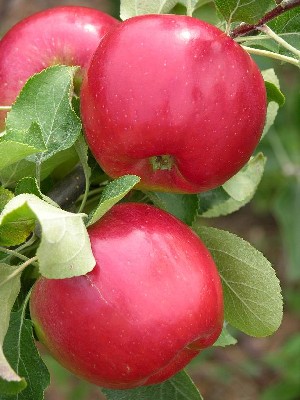
Redfree: (AKA Co Op 13) Raritan x PRI 1018-101; PRI (Purdue, Rutgers, Illinois Co-Op) introduced in 1981. Smooth, waxy, russet-free skin. Light flesh is crisp and juicy. The first disease resistant apple of the season, Redfree matures in mid July. Considered a dessert quality apple with bright red color over a yellow background. The tree is semi-upright and crops annually. It is resistant to apple scab and cedar apple rust.
Gingergold: Discovered as a chance seedling on the orchards of Clyde and Ginger Harvey of Lovingston, VA, this Golden Delicious-type apple ripens six weeks ahead of Golden Delicious and can be harvested the first week of August in Adams County. Ginger Gold® exhibits all the qualities of a fall variety and ripens three weeks before McIntosh. The highest quality early season yellow dessert apple available.
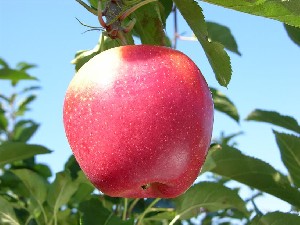
Initial: A scab-resistant variety developed at INRA Angers, France Initial is a Gala x Redfree cross. It matures approximately one week before Gala. The fruit has good size and is a red blush over a yellow background. Tree is relatively non-vigorous and the fruit is crisp with a mild acidic flavor.
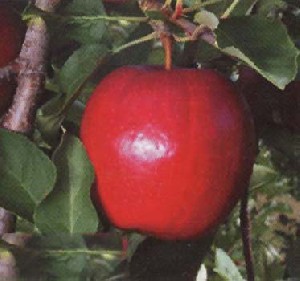
Gale Gala: Gale Gala® is the "one -pick" Gala strain - the highest coloring Gala currently on the market! A strikingly attractive apple from New Zealand, Gala is a cross between Golden Delicious & Kidd’s Orange Red. The creamy flesh is crisp & dense with a spritely sweet aromatic flavor. Great for fresh eating, drying & cider. A whole tree sport of Royal Gala, this outstanding new strain has all the winning characteristics of its parent but has deeper red stripes and a fuller red color.
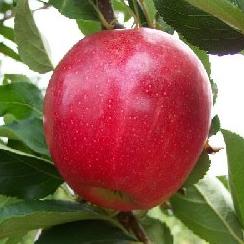
Crimson Gala: Intense coloring striped strain of Gala, discovered in a block of Royal Gala in Milton, Oregon. It’s pale creamy flesh is crisp and dense, with a mild sweet flavor. The outstanding aroma and taste are excellent for fresh eating, cider and drying. Recommended those who prefer full color with a prominent stripe.
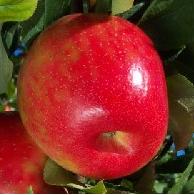
Honeycrisp: Origin: Keepsake x ??? [Parentage verified by DNA tests in 2004]; University of Minnesota, 1991 release. Harvest: mid September to October; Season: September - January. Description: Color is red mottled over a yellow background. Has excellent eating and keeping qualities. SIGNIFICANT POLYGENETIC SCAB AND BLIGHT RESISTANCE IN FIELD TRIALS. Can develop multiple issues with long-term storage.
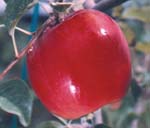
Auvil Early Fuji: When Grady Auvil discovered this new Fuji sport in his orchard, he predicted, "It will revolutionize the Fuji market." Born from a combination of Red Delicious and Ralls Janet, it is easy to see why Fuji is the most popular variety in Asia. When grown in the South, the creamy, firm, fine-grained flesh fills your mouth with its juicy sweetness. This sensational new strain matures about six weeks ahead of standard Red Fuji yet produces a higher percentage of Extra Fancy fruit.
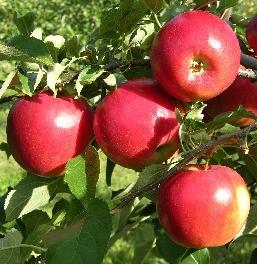
Crimson Crisp: (AKA Co Op 39) An exciting new disease-resistant variety being offered for the first time in the spring of 2006. The fruit is medium in size with a very attractive crimson red over green background color; best described as “Christmassy”. Crimson Crisp has a very firm, crisp texture with a complex tart flavor; excellent for fresh eating and cider making. The fruit matures mid-season and will keep in cold for six months.

Sweet 16: Parentage / Origin: Northern Spy x MN 447; Minnesota, 1973. Harvest: September - October, Season: stores well. Description: Large, red striped fruit. Firm, crisp, aromatic flesh. Moderately acidic. Tree Characteristics: Resistant to scab and fire blight. Early annual bearing, hardy and vigorous tree.

Liberty: Origin: Macoun x Purdue 54-12; New York, 1978. Harvest: October, Season: November - Feb. Description: MacIntosh type apple. Large, red blush covering nearly all of this yellow fruit. Flavor develops over one month in storage. Tree Characteristics: Very disease-resistant. Heavy fruit sets require thinning.
Golden Delicious: Unrelated to Red Delicious, America’s original favorite began as a chance seedling near Bomont, West Virginia. Ours is a russet resistant selection of the original. Fruit is firm, medium to large with the classic mellow flavor. Great for fresh eating, cooking & cider.

Grime’s Golden: Origin: West Virginia, 1832. Harvest: October; Season: October - January. Description: Multiple uses, superior eating apple, great cider, and keeps well. Medium to large clear yellow fruit. Flesh is crisp, fine-grained, and juicy yellow flesh. Rich, distinctive, aromatic spicy flavor. Tree Characteristics: Tree bears young. Moderately resistant to fire blight and cedar-apple rust.
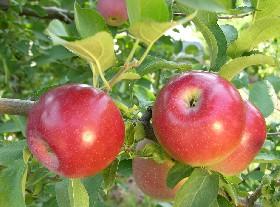
Crown Empire: A red blush sport discovered at Crist Brothers Orchard, Walden, NY in 1990. Exhibits full red color two weeks ahead of standard Empire. Born of Red Delicious and McIntosh parents, this apple is superior to both parents in flavor and storability. The creamy white flesh is crisp & juicy; sweeter than it is tart. Excellent for fresh eating, cooking & cider. The trees also have unique pink blooms.
Freedom: A cross of Macoun and Golden Delicious from the Geneva Apple Breeding Program in 1983, this large multi-purpose apple is good for fresh eating, sauce, and juice. Color is red stripe over yellow background with a cream-colored, medium-firm flesh. Freedom blooms three days after McIntosh and ripens with Red Delicious. Tree is resistant to most apple tree diseases.
Hampshire MacIntosh: A McIntosh-type apple discovered by Erick Ledbetter of Contoocook, NH that is well suited to our micro-climate. The fruit is deep red and firm, with a crisp, juicy texture. Excellent for fresh eating, cooking, drying and cold storage.
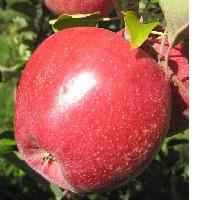
Cameo: A chance seedling found by Darrel Caudle near Dryden, Washington in 1987; this fruit is firm, crisp and characterized by a highly appealing subacid, aromatic flavor. Fruit shape is conic, very similar to Delicious but without the bumps on the bottom. The apple color is bright red stripe over a creamy background. Matures one week before Fuji and has a long picking window with Storage quality comparable to Fuji.
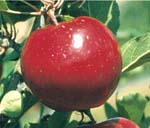
Red Rome Beauty: An early coloring Rome Beauty sport that finishes to a beautiful bright red. Fruit is medium to large in size and tends to be longer and more conical in shape than standard rome beauty. The variety can be used for processing or fresh packing. The tree is both productive and vigorous.

Mutsu Crispin: Golden Delicious x Indo 1930. Harvest late September, keeping into February. Green fruit ripens to golden. In Japan, it's known as the Million Dollar Apple, selling at high prices. The fruit is large, oblong, and irregular. The smooth greenish-yellow skin is waxy and clear. The dense flesh is crisp, juicy and coarse-grained with a sprightly flavor. A vigorous grower, the fruit does not russet and will not shrivel in storage. Hot, dry weather enhances the spicy flavor and the fruit remains intact when cooked. Great for dessert, cooking and cider making.

Enterprise: (AKA Co-op 30) Born of the Purdue Rutgers Illinois Co-Op breeding program in 1993, this fruit is round and large with glossy full red color. Flesh is yellow-cream, firm, crisp, or somewhat similar to Idared. Storability is 4-6 months with a slight increase in flavor intensity. Resistant to most apple diseases.
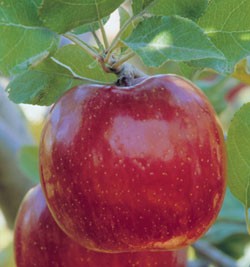
Autumn Rose Fuji: An improved red sport of Fuji with the same outstanding qualities of the original. The fruit is large, very firm and colors with a prominent red stripe over a yellow background color and matures later in the season than standard Fuji. Fuji is the best keeper of any of the sweet varieties and consistently scores at the top in taste test.
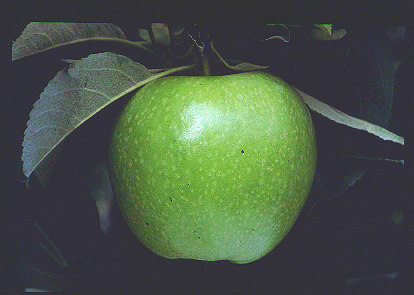
Granny Smith: This green apple import from Australia has become an American standard. Consumers like it for its tart, crisp and juicy flavor and outstanding keeping qualities. Granny Smith is used for both fresh packs and processing and produces large, round fruit. The tree is vigorous and sets crops early. This is a late maturing variety and is best suited for areas with long growing seasons.

Goldrush: (AKA Co-op 38) Co Op 17 x Golden Delicious; PRI (Purdue, Rutgers, Illinois Co Op), 1994. Description: Fruit is conic-round, medium large, and a deep uniform greenish yellow. Flesh is hard, very crisp and breaking. Sugar-acid balance slightly favors tartness at harvest, mellowing slightly in storage. Storage exceeds 6 months.
ADDITIONAL VARIETIES AVAILABLE BEGINNING IN 2011

Akane: (AKA Prime Red) A cross of the venerable Jonathan and Worcester Pearmain, this apple was released in Japan around 1970. This round, bright red variety comes highly recommended as a desert apple with crisp, juicy, white flesh and a tart/sweet, sprightly flavor resembling Jonathan. Good for drying and sauce. If you leave the skin on, Akane will make tasty pink sauce. It is also a better keeper than most fall varieties.
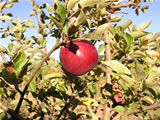
Arkansas Black: Thought to be a seedling of Winesap, this variety originated in Benton County, Arkansas around 1870. Keeps all winter. Beneath the beautiful dark waxy red skin, the golden flesh is crisp, juicy & very firm. The fruits turn nearly black at maturity. Distinctive aromatic flavor lends itself well to cider blending or fermentation. These medium, smooth, round fruits are of very good quality for fresh eating or cooking. Flavor improves and mellows in storage.
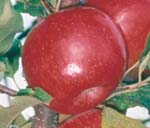
Banning Red Fuji: An improved-coloring sport of Fuji that features high color, pinkish-red skin and outstanding striping. It has very sweet flesh and the firm, crisp texture that made its parent famous. The fruit is large and of excellent quality. This sport is a good choice for poor coloring areas or for anyone looking for enhanced color on this late-season favorite.

Buckeye Gala: Discovered as a sport of Imperial Gala at Peace Valley Orchards in Rogers, Ohio as a cross of Golden Delicious and Kidd’s Orange Red from New Zealand. Its pale creamy flesh is crisp and dense, with a mild sweet flavor. The outstanding aroma and taste are excellent for fresh eating, cider and drying. Buckeye Gala is a highly red sport of Gala, almost solid red with a deep burgundy stripe. The fruit matures with other Gala selections and is comparable in size, firmness and fruit quality.

Crimson Topaz: A cross of Rubin and Vanda, Crimson® Topaz is a promising new disease resistant dessert apple harvesting one week before Golden Delicious. The fruit is medium in size, crisp and juicy with good flavor. It has a 50% orange-red striping color over a yellow background. The growth habit is spur-like, vigorous and upright. Crimson® Topaz is a precocious cropper and the fruit does not drop.

Dayton: (AKA Co Op 21 PRI) Introduced from the Purdue Rutgers Illinois Co-Op breeding program in 1988, this fruit is large, full red and sweet. It appears to possess good resistance to all major apple diseases. Among the very best Purdue selections. The brilliant red fruit is crisp, juicy, sweet-tart and very flavorful. Great for fresh eating and cider.

Murray: Medium-large fruit ripening about 2 weeks before Liberty, a week before McIntosh; dark red; attractive. Very juicy, good sugar/acid balance, good eating apple, but not for cooking. Productive and even-bearing.
Pink Lady: (AKA Cripp’s Pink) Golden Delicious x Lady Williams; Western Australian apple breeding program. Harvest: November. Description: Oblong, green fruit turns yellow at maturity and is overlaid with pink or light red. Fine-grained, white flesh. Thin skin bruises easily. Fruit will store for six to eight months in common storage. Tree Characteristics: Tree is very vigorous with large distinctive leaves.
Red Delicious, “Adams Apple”: (Burchinal cultivar) USPP# 14757. A limb sport of the Oregon Spur® II, our Red Delicious beats anything you can buy in a store. If color is a problem in your area (and it is in Georgia), Adams Apple® is the Red Delicious for you! This new strain is lipstick red from petal fall to picking and produces large, typey fruit with very sweet white, juicy and aromatic flesh. America’s favorite fresh apple!

Scarlet O’Hara: (AKA Co Op 25) PRI Co-Op. Harvest: mid-September. Fruit is round-conic, full blushed red, sweet and juicy. Hangs extremely well on the tree and sugars increase greatly until early October. Tree Characteristics: From the scab-resistant breeding program of Purdue, this is one of the highest quality and most productive varieties. It can be picked and actually tastes very similar when harvested over a 4-week period from late September to late October. It is one of the crispest and best storing apples evaluated. It has a mild, fruity, vanilla flavor with a good sugar to acid ratio.

Sir Prize: (AKA Co Op 5) Tetraploid Golden Delicious x PRI 14-152), 1975. Harvest: October Description: Large greenish yellow fruit. High quality, but very thin tender skin that bruises easily. Very sweet, scented taste, crisp & juicy. Tree Characteristics: Strong, vigorous, spreading tree. Immune to scab; resistant to mildew. Excellent home garden apple. Tender (yet crisp) flesh is extremely sensitive to bruising, which makes it difficult as a commercial cultivar, although fruit size, finish, and fine quality make it ideal for the home garden; susceptibility to cedar-apple rust is a problem in some areas; susceptibility to fire blight is a problem in some areas; triploid with unviable pollen so it requires an additional pollinizer. General Recommendation: Suggested for limited use in pick-your-own operations and as a home grower cultivar. 'Sir Prize' is currently the only widely available, yellow scab resistant apple in 'Golden Delicious' season.

Smokehouse: (Gibbons Smokehouse, Mill Creek, Red Vandevere) - A wonderful and very flavorful apple that originated in the 1830's with William Gibbons of Lancaster County, Pennsylvania. The original tree grew up near the smokehouse of Mr. Gibbons and thus its name was derived. Besides its excellent eating qualities, Smokehouse is a fine cooking and baking apple. The apple has greenish-yellow skin covered with shades and stripes of red. Flesh is yellowish, crisp and firm with a pleasing spicy flavor. Ripens September or later depending on the locale.

Snapp Stayman: (Stayman Winesap) - Stayman is a progeny of Winesap and like its well-known and historic parent, is an apple of the highest quality. The apple arose in 1866 when Dr. Stayman planted seeds of Winesap on his farm in Leavenworth, Kansas. Like Winesap, it has sterile pollen and cannot pollinate other apple trees. Fruit is medium to large with smooth greenish-yellow skin mostly covered with stripes and splashes of red and crimson. The tangy whitish-yellow flesh is firm, crisp, and juicy. Ripens in October.

William’s Pride: USPP #6,268 (AKA Co Op 23) Parentage / Origin: PRI 1018-101 x NJ 50;1988. Harvest: late July. Description: Fruit is medium in size slightly conic in shape with a rich aromatic flavor. Apples are 70-80% red with excellent eating quality. Tree Characteristics: Resistance to apple scab and cedar apple rust. Good resistance to fireblight and powdery mildew.

Yates: Yates originated with Matthew Yates of Fayette County, Georgia, around 1844. Long a popular Southern favorite prized for its fine flavor and long keeping qualities. Grows well in all regions from the mountains to the coast. Fruit is small to very small with yellowish-white skin covered with red stripes and dark red shading. The yellowish-white flesh is tender, juicy and aromatic. Ripens in October and keeps very well until April.
© 2009 Freedom Farms
.jpg)
